Organisational Culture Analysis: Warrick (2017) and Yu & Shih (2018)
VerifiedAdded on 2022/09/28
|5
|1144
|16
Report
AI Summary
This report presents a critical analysis of two articles focusing on organisational culture: Warrick (2017) and Yu & Shih (2018). Warrick (2017) emphasizes the significance of culture for organisational success, differentiating between high and low-performance cultures and highlighting the crucial role of leaders in shaping and managing culture. The article also discusses the importance of building culture by design. Yu and Shih (2018) propose a people-centered and value-focused approach to developing an innovative organisational culture, drawing on case studies of 3M and SRI International. This approach incorporates organisational values and alignment, team motivation and development, and innovation selection and commitment. The analysis contrasts the articles, noting their agreement on the importance of organisational culture but differing perspectives on leadership roles. The report concludes by suggesting the need for further research, especially concerning conflict management and leadership variations across different organisational setups.
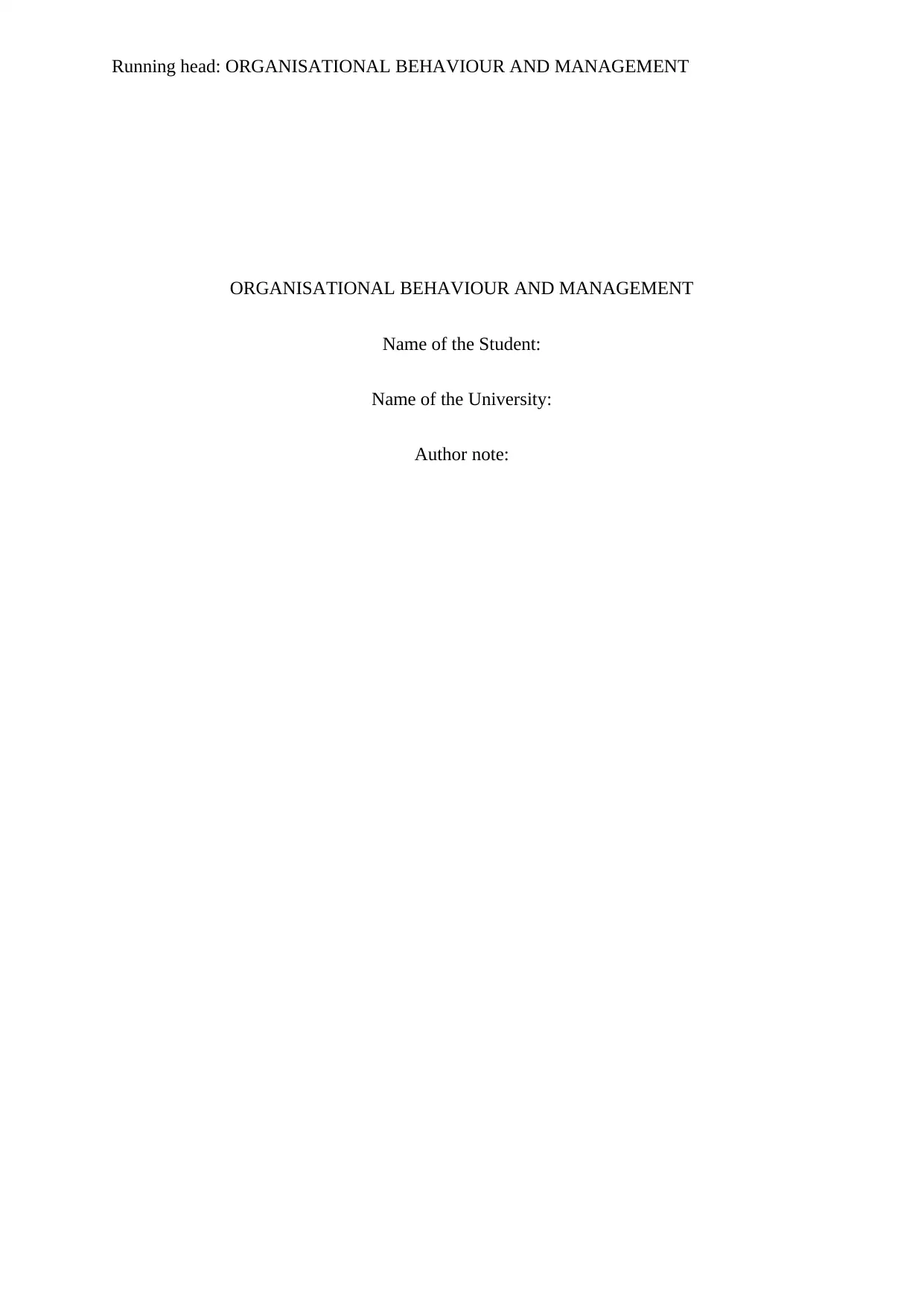
Running head: ORGANISATIONAL BEHAVIOUR AND MANAGEMENT
ORGANISATIONAL BEHAVIOUR AND MANAGEMENT
Name of the Student:
Name of the University:
Author note:
ORGANISATIONAL BEHAVIOUR AND MANAGEMENT
Name of the Student:
Name of the University:
Author note:
Paraphrase This Document
Need a fresh take? Get an instant paraphrase of this document with our AI Paraphraser
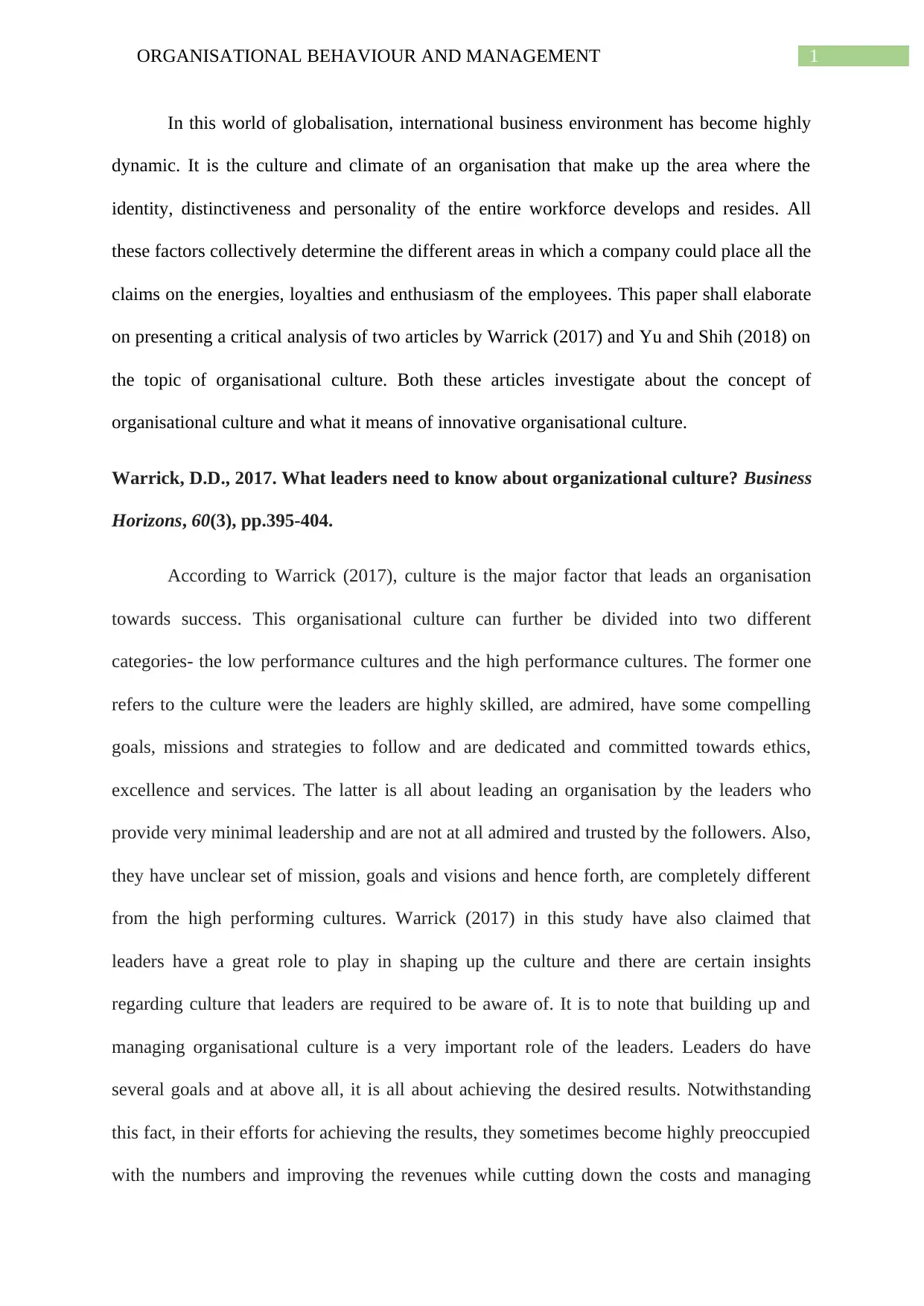
1ORGANISATIONAL BEHAVIOUR AND MANAGEMENT
In this world of globalisation, international business environment has become highly
dynamic. It is the culture and climate of an organisation that make up the area where the
identity, distinctiveness and personality of the entire workforce develops and resides. All
these factors collectively determine the different areas in which a company could place all the
claims on the energies, loyalties and enthusiasm of the employees. This paper shall elaborate
on presenting a critical analysis of two articles by Warrick (2017) and Yu and Shih (2018) on
the topic of organisational culture. Both these articles investigate about the concept of
organisational culture and what it means of innovative organisational culture.
Warrick, D.D., 2017. What leaders need to know about organizational culture? Business
Horizons, 60(3), pp.395-404.
According to Warrick (2017), culture is the major factor that leads an organisation
towards success. This organisational culture can further be divided into two different
categories- the low performance cultures and the high performance cultures. The former one
refers to the culture were the leaders are highly skilled, are admired, have some compelling
goals, missions and strategies to follow and are dedicated and committed towards ethics,
excellence and services. The latter is all about leading an organisation by the leaders who
provide very minimal leadership and are not at all admired and trusted by the followers. Also,
they have unclear set of mission, goals and visions and hence forth, are completely different
from the high performing cultures. Warrick (2017) in this study have also claimed that
leaders have a great role to play in shaping up the culture and there are certain insights
regarding culture that leaders are required to be aware of. It is to note that building up and
managing organisational culture is a very important role of the leaders. Leaders do have
several goals and at above all, it is all about achieving the desired results. Notwithstanding
this fact, in their efforts for achieving the results, they sometimes become highly preoccupied
with the numbers and improving the revenues while cutting down the costs and managing
In this world of globalisation, international business environment has become highly
dynamic. It is the culture and climate of an organisation that make up the area where the
identity, distinctiveness and personality of the entire workforce develops and resides. All
these factors collectively determine the different areas in which a company could place all the
claims on the energies, loyalties and enthusiasm of the employees. This paper shall elaborate
on presenting a critical analysis of two articles by Warrick (2017) and Yu and Shih (2018) on
the topic of organisational culture. Both these articles investigate about the concept of
organisational culture and what it means of innovative organisational culture.
Warrick, D.D., 2017. What leaders need to know about organizational culture? Business
Horizons, 60(3), pp.395-404.
According to Warrick (2017), culture is the major factor that leads an organisation
towards success. This organisational culture can further be divided into two different
categories- the low performance cultures and the high performance cultures. The former one
refers to the culture were the leaders are highly skilled, are admired, have some compelling
goals, missions and strategies to follow and are dedicated and committed towards ethics,
excellence and services. The latter is all about leading an organisation by the leaders who
provide very minimal leadership and are not at all admired and trusted by the followers. Also,
they have unclear set of mission, goals and visions and hence forth, are completely different
from the high performing cultures. Warrick (2017) in this study have also claimed that
leaders have a great role to play in shaping up the culture and there are certain insights
regarding culture that leaders are required to be aware of. It is to note that building up and
managing organisational culture is a very important role of the leaders. Leaders do have
several goals and at above all, it is all about achieving the desired results. Notwithstanding
this fact, in their efforts for achieving the results, they sometimes become highly preoccupied
with the numbers and improving the revenues while cutting down the costs and managing
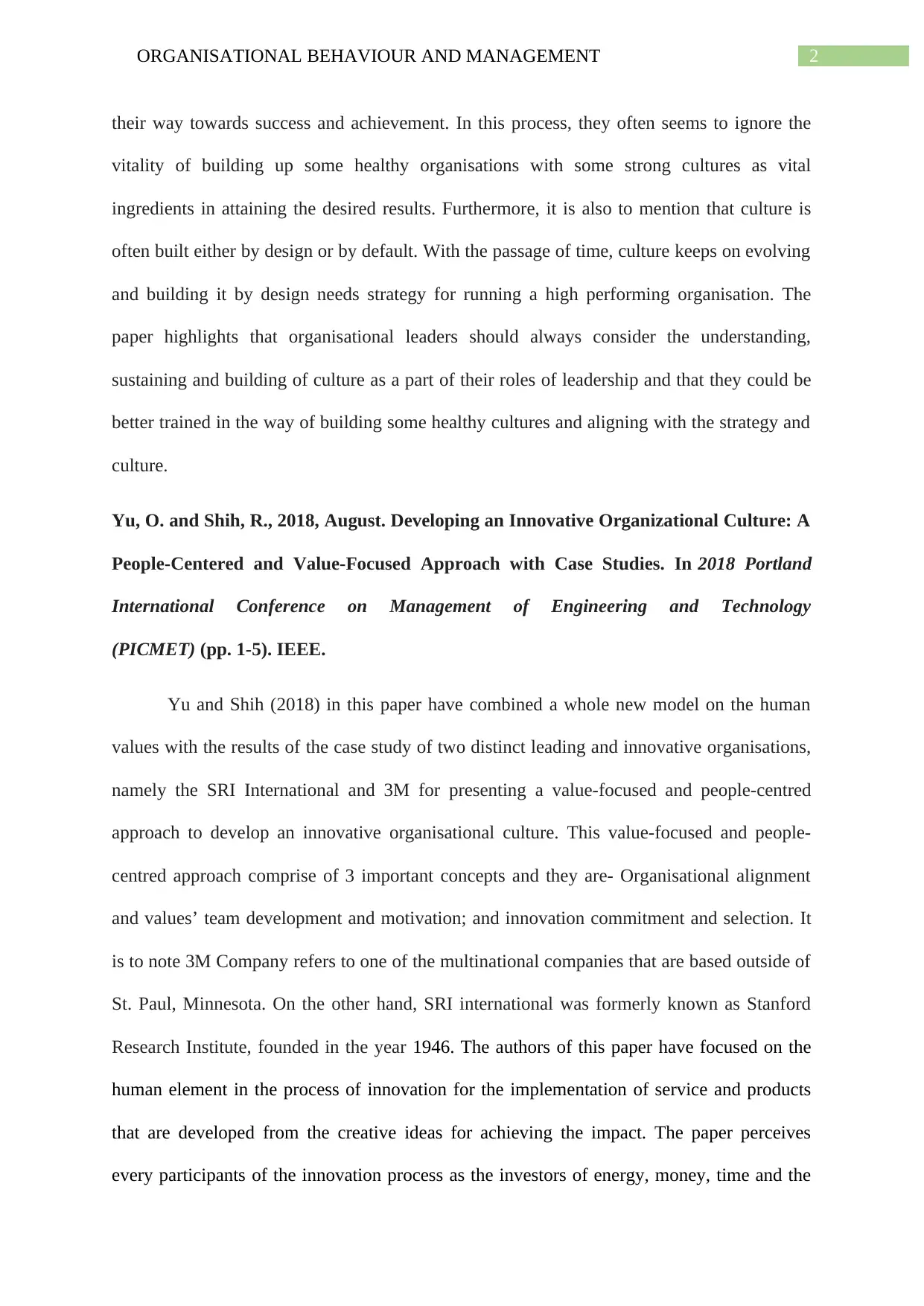
2ORGANISATIONAL BEHAVIOUR AND MANAGEMENT
their way towards success and achievement. In this process, they often seems to ignore the
vitality of building up some healthy organisations with some strong cultures as vital
ingredients in attaining the desired results. Furthermore, it is also to mention that culture is
often built either by design or by default. With the passage of time, culture keeps on evolving
and building it by design needs strategy for running a high performing organisation. The
paper highlights that organisational leaders should always consider the understanding,
sustaining and building of culture as a part of their roles of leadership and that they could be
better trained in the way of building some healthy cultures and aligning with the strategy and
culture.
Yu, O. and Shih, R., 2018, August. Developing an Innovative Organizational Culture: A
People-Centered and Value-Focused Approach with Case Studies. In 2018 Portland
International Conference on Management of Engineering and Technology
(PICMET) (pp. 1-5). IEEE.
Yu and Shih (2018) in this paper have combined a whole new model on the human
values with the results of the case study of two distinct leading and innovative organisations,
namely the SRI International and 3M for presenting a value-focused and people-centred
approach to develop an innovative organisational culture. This value-focused and people-
centred approach comprise of 3 important concepts and they are- Organisational alignment
and values’ team development and motivation; and innovation commitment and selection. It
is to note 3M Company refers to one of the multinational companies that are based outside of
St. Paul, Minnesota. On the other hand, SRI international was formerly known as Stanford
Research Institute, founded in the year 1946. The authors of this paper have focused on the
human element in the process of innovation for the implementation of service and products
that are developed from the creative ideas for achieving the impact. The paper perceives
every participants of the innovation process as the investors of energy, money, time and the
their way towards success and achievement. In this process, they often seems to ignore the
vitality of building up some healthy organisations with some strong cultures as vital
ingredients in attaining the desired results. Furthermore, it is also to mention that culture is
often built either by design or by default. With the passage of time, culture keeps on evolving
and building it by design needs strategy for running a high performing organisation. The
paper highlights that organisational leaders should always consider the understanding,
sustaining and building of culture as a part of their roles of leadership and that they could be
better trained in the way of building some healthy cultures and aligning with the strategy and
culture.
Yu, O. and Shih, R., 2018, August. Developing an Innovative Organizational Culture: A
People-Centered and Value-Focused Approach with Case Studies. In 2018 Portland
International Conference on Management of Engineering and Technology
(PICMET) (pp. 1-5). IEEE.
Yu and Shih (2018) in this paper have combined a whole new model on the human
values with the results of the case study of two distinct leading and innovative organisations,
namely the SRI International and 3M for presenting a value-focused and people-centred
approach to develop an innovative organisational culture. This value-focused and people-
centred approach comprise of 3 important concepts and they are- Organisational alignment
and values’ team development and motivation; and innovation commitment and selection. It
is to note 3M Company refers to one of the multinational companies that are based outside of
St. Paul, Minnesota. On the other hand, SRI international was formerly known as Stanford
Research Institute, founded in the year 1946. The authors of this paper have focused on the
human element in the process of innovation for the implementation of service and products
that are developed from the creative ideas for achieving the impact. The paper perceives
every participants of the innovation process as the investors of energy, money, time and the
⊘ This is a preview!⊘
Do you want full access?
Subscribe today to unlock all pages.

Trusted by 1+ million students worldwide
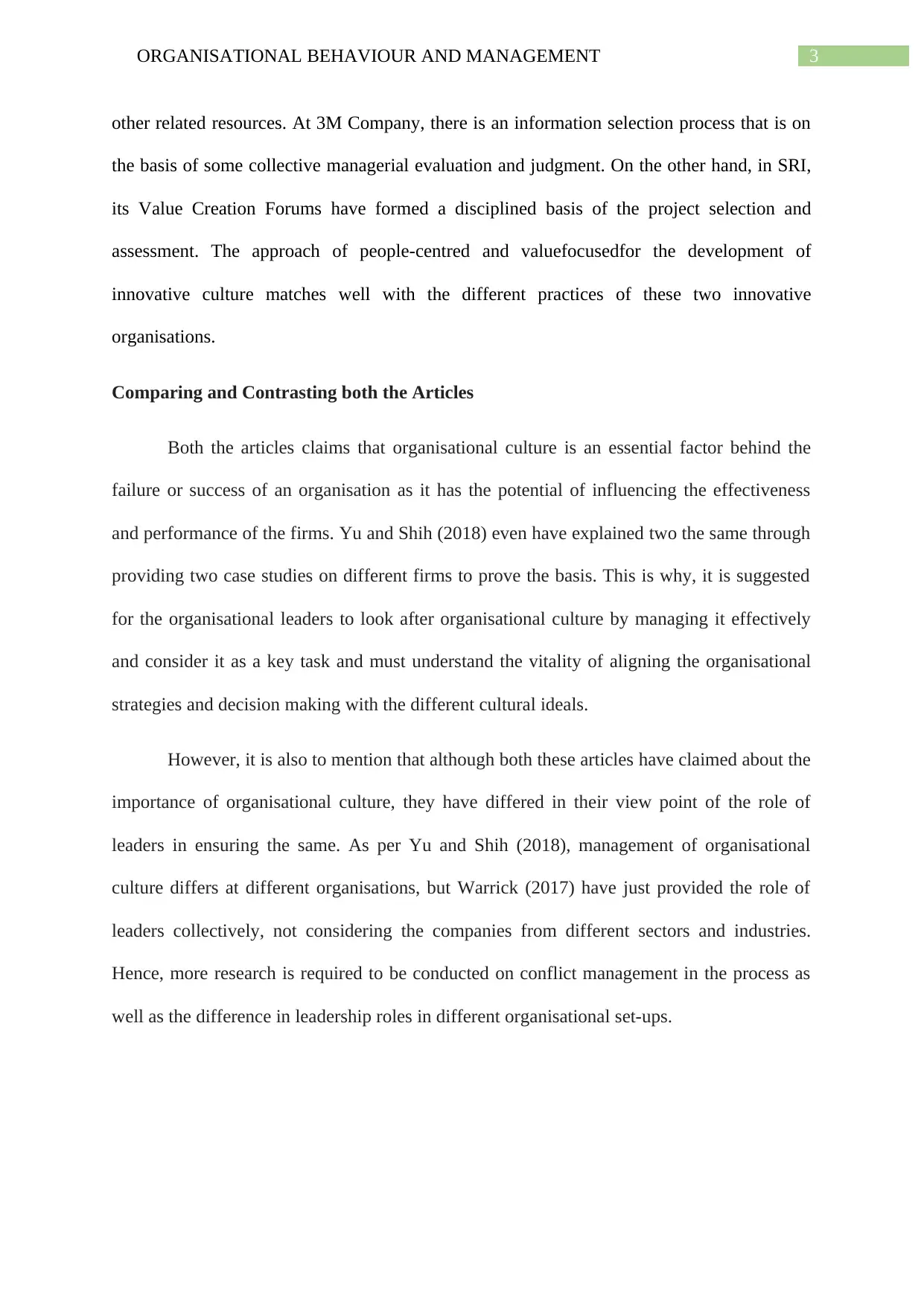
3ORGANISATIONAL BEHAVIOUR AND MANAGEMENT
other related resources. At 3M Company, there is an information selection process that is on
the basis of some collective managerial evaluation and judgment. On the other hand, in SRI,
its Value Creation Forums have formed a disciplined basis of the project selection and
assessment. The approach of people-centred and valuefocusedfor the development of
innovative culture matches well with the different practices of these two innovative
organisations.
Comparing and Contrasting both the Articles
Both the articles claims that organisational culture is an essential factor behind the
failure or success of an organisation as it has the potential of influencing the effectiveness
and performance of the firms. Yu and Shih (2018) even have explained two the same through
providing two case studies on different firms to prove the basis. This is why, it is suggested
for the organisational leaders to look after organisational culture by managing it effectively
and consider it as a key task and must understand the vitality of aligning the organisational
strategies and decision making with the different cultural ideals.
However, it is also to mention that although both these articles have claimed about the
importance of organisational culture, they have differed in their view point of the role of
leaders in ensuring the same. As per Yu and Shih (2018), management of organisational
culture differs at different organisations, but Warrick (2017) have just provided the role of
leaders collectively, not considering the companies from different sectors and industries.
Hence, more research is required to be conducted on conflict management in the process as
well as the difference in leadership roles in different organisational set-ups.
other related resources. At 3M Company, there is an information selection process that is on
the basis of some collective managerial evaluation and judgment. On the other hand, in SRI,
its Value Creation Forums have formed a disciplined basis of the project selection and
assessment. The approach of people-centred and valuefocusedfor the development of
innovative culture matches well with the different practices of these two innovative
organisations.
Comparing and Contrasting both the Articles
Both the articles claims that organisational culture is an essential factor behind the
failure or success of an organisation as it has the potential of influencing the effectiveness
and performance of the firms. Yu and Shih (2018) even have explained two the same through
providing two case studies on different firms to prove the basis. This is why, it is suggested
for the organisational leaders to look after organisational culture by managing it effectively
and consider it as a key task and must understand the vitality of aligning the organisational
strategies and decision making with the different cultural ideals.
However, it is also to mention that although both these articles have claimed about the
importance of organisational culture, they have differed in their view point of the role of
leaders in ensuring the same. As per Yu and Shih (2018), management of organisational
culture differs at different organisations, but Warrick (2017) have just provided the role of
leaders collectively, not considering the companies from different sectors and industries.
Hence, more research is required to be conducted on conflict management in the process as
well as the difference in leadership roles in different organisational set-ups.
Paraphrase This Document
Need a fresh take? Get an instant paraphrase of this document with our AI Paraphraser
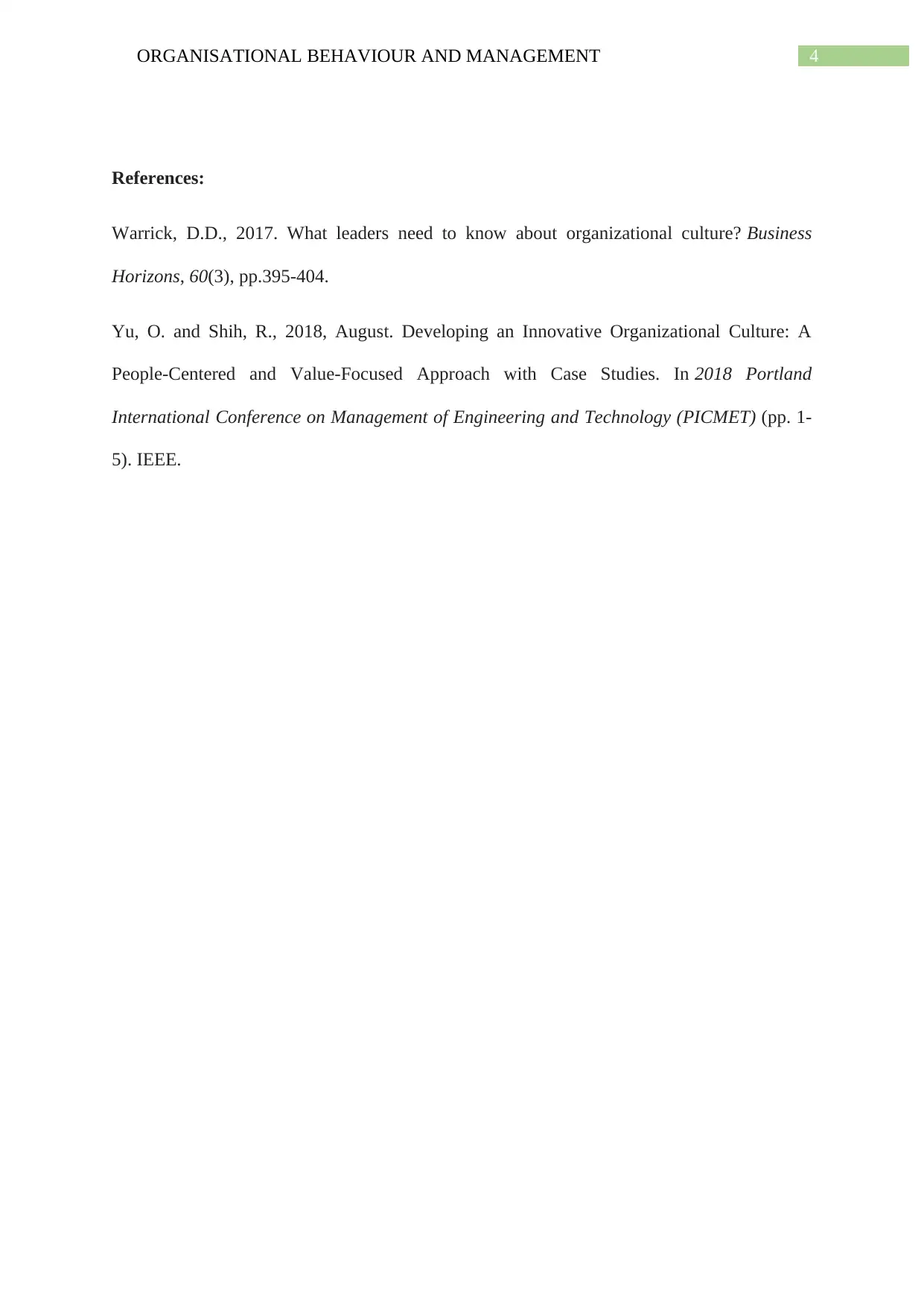
4ORGANISATIONAL BEHAVIOUR AND MANAGEMENT
References:
Warrick, D.D., 2017. What leaders need to know about organizational culture? Business
Horizons, 60(3), pp.395-404.
Yu, O. and Shih, R., 2018, August. Developing an Innovative Organizational Culture: A
People-Centered and Value-Focused Approach with Case Studies. In 2018 Portland
International Conference on Management of Engineering and Technology (PICMET) (pp. 1-
5). IEEE.
References:
Warrick, D.D., 2017. What leaders need to know about organizational culture? Business
Horizons, 60(3), pp.395-404.
Yu, O. and Shih, R., 2018, August. Developing an Innovative Organizational Culture: A
People-Centered and Value-Focused Approach with Case Studies. In 2018 Portland
International Conference on Management of Engineering and Technology (PICMET) (pp. 1-
5). IEEE.
1 out of 5
Related Documents
Your All-in-One AI-Powered Toolkit for Academic Success.
+13062052269
info@desklib.com
Available 24*7 on WhatsApp / Email
![[object Object]](/_next/static/media/star-bottom.7253800d.svg)
Unlock your academic potential
Copyright © 2020–2025 A2Z Services. All Rights Reserved. Developed and managed by ZUCOL.




